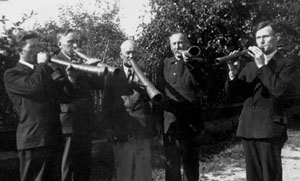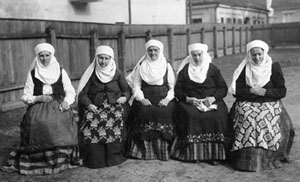Songs, Sutartines and Instrumental Music from Aukštaitija. Phonograph records of 1935–1941. Edited by Austė Nakienė and Rūta Žarskienė. Sound restoration by Skirmantas Sasnauskas. 77 records and transcriptions, 47 texts, 42 photos, 2 articles. Vilnius: Institute of Lithuanian Literature and Folklore, 2004, 223 P. ISMN M-706239-03-3
Two CDs provide traditional music of Aukštaitija recorded on the phonograph discs in 1935–1941. Aukštaitija region (North-eastern Lithuania) is famous for the music making of exceedingly high singularity. In this region polyphonic songs sutartinės containing a whole system of the elements of archaic musical and poetic expression were sung. Along with vocal polyphony, peculiar instrumental music existed which was blown on multi-pipe whistles skudučiai and wooden trumpets ragai.
In the currently compiled collection the unique examples of the ancient polyphony are presented. On the phonograph discs the very last performances of singers of sutartinės and of old players on multi-pipe whistles and trumpets are documented (groups of singers form Biržai, Tatkūnai, Vidiškiai, Užulėnis, and Šimonys, as well as skudučiai players from Biržai, and ragai blowers from Vabalninkas). The publication also presents a few sutartinės played on five-string kanklės (zither type instrument) recorded from Jonas Plepas and Petras Lapienė.
In addition to the ancient polyphony other styles of traditional music from Aukštatija have been included in the colection. Although multi-part style of singing was prevalent in this region, in the outskirts of the eastern part of Aukštaitija songs of various genres were performed in the monodic style. The publication provides a few of archaic ritual songs that are sung by the singer Marijona Kazlauskienė from Adutiškis. Particularly in this region the cimbolai (hammered dulcimer) found their spread, the tunes of polkas, waltzes and suktinis (Lithuanian folk dance) in octaves or monophonically were played on them. Quite a few available songs of shepherds also have been selected from the records, these songs are interrupted by musical instruments: lamzdelis ( longitudinal pipe ) and goat horn on which shepherds’ melodies are blown.
Songs and instrumental music played at the most solemn parts at weddings distinguished themselves by the great diversity of styles. Traditional wedding songs of Aukštaitija were sung with the accompaniment of thirds (singers from Kupiškis, and Ukmergė). P olkas, waltzes and other dances were played by instrumental ensembles of various compositions (fiddlers from Biržai, musicians from Pyragiai, and musicians from Ukmergė). The playing of the fiddler Juozas Gudėnas from Švenčionys environs was put on records; he played the melodies of the dances that might have been ritual dances of earlier times.
In the book “Songs, Sutartinės and Instrumental Music from Aukštaitija” texts, melodies, comments, and photographs have been published.
Players from Vabalninkas, 1936

Singers from Kupiškis, 1936
© 2004 Lietuvių literatūros ir tautosakos institutas